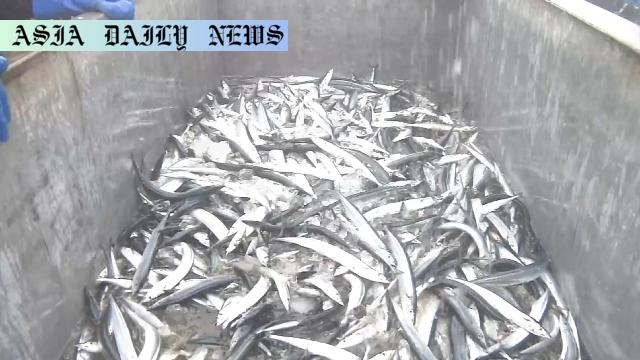Pacific saury: Japan considers increasing fishing boat size limits to improve catch viability amidst declining saury populations and competition.
Japan seeks to raise limits on the size and capacity of Pacific saury fishing boats.
The current limit of 200 tons affects catch viability in distant waters.
China and Taiwan operate larger 1,000-ton vessels, increasing their competitiveness.
Rising sea temperatures are impacting Pacific saury populations and shifting fishing zones.

Japan’s Pacific Saury Catch Challenges
Japan, renowned for its proficient fisheries and maritime traditions, is grappling with a significant obstacle in its Pacific saury industry. The Fisheries Agency of Japan has proposed a transformative plan to address the decreasing productivity linked to longstanding regulations. At present, Japanese fishing boats designated for catching Pacific saury must be less than 200 tons. This restriction has proven increasingly detrimental, as shifting fishing grounds and rising sea temperatures demand larger, more equipped vessels for a competitive edge. With Pacific saury populations migrating farther from Japanese coastal waters to the deeper regions of the North Pacific Ocean, Japan risks being eclipsed by neighboring competitors such as China and Taiwan, countries that have invested heavily in larger, more capable vessels.
The Shift of Fishing Grounds and Its Implications
The migration of Pacific saury populations toward the North Pacific Ocean signifies a stark biological response to climatic changes. Rising sea temperatures, an undeniable consequence of global warming, directly contribute to altering ecosystems. Consequently, Japan’s once-thriving saury fishing fields have endured depletion, forcing the industry to pursue these fish farther offshore. However, longer expeditions necessitate vessels capable of storing larger quantities of fuel and implementing advanced refrigeration technologies to maintain the freshness of hauls. Japan’s existing 200-ton regulatory cap on fishing boat size severely limits the feasibility of such excursions, necessitating immediate policy revisions.
Competitive Disparities with China and Taiwan
One of the driving forces behind Japan’s reconsideration is the stark disparity between its fishing infrastructure and that of neighboring nations, such as China and Taiwan. These countries have aggressively invested in high-capacity fishing operations, deploying vessels exceeding 1,000 tons to effectively dominate resources on the high seas. The substantial size of these vessels allows for longer expeditions, greater fuel capacity, and sophisticated equipment. As a result, while Japan’s Pacific saury catches have declined, China and Taiwan have witnessed surges despite similar ecological and environmental challenges. To regain its foothold in this vital sector, Japan must make bold policy shifts to level the playing field.
A Step Toward Reform
The proposed lifting of regulations on vessel size represents a critical step for Japan to remain competitive in the maritime fishing industry. By adjusting its laws to reflect the contemporary challenges and competition, Japan not only aims to boost its dwindling catch yields but also seeks to revitalize an integral sector of its economy. These reforms will enable Japanese fishermen to deploy larger vessels equipped with modern refrigeration and fuel storage systems that ensure efficiency and commercial viability. However, such a transformation must prioritize sustainability to balance immediate economic gains with long-term conservation efforts.
The Importance of Sustainable Practices
While expanding the permissible size of fishing vessels is a logical economic response, this decision requires careful calibration to avoid overexploitation of Pacific saury populations. Integrating environmentally conscious strategies such as catch quotas, monitoring technologies, and international cooperation can help Japan achieve equilibrium between competitiveness and resource conservation. Innovations in vessel design that focus on energy efficiency and minimizing bycatch can further enhance the sustainability of this initiative, ensuring that the Pacific saury industry thrives without depleting oceanic ecosystems.
Commentary
Recognizing the Pressures on Japan’s Fishing Industry
Japan’s consideration of easing regulations on Pacific saury fishing boats underscores the country’s acute awareness of the ongoing challenges posed by climate change and international competition. The shift of Pacific saury fishing grounds to the North Pacific Ocean, driven by rising sea temperatures, reveals how environmental factors are reshaping economic activities globally. Japanese fishermen, who once depended on thriving local waters, now face the dilemma of traversing vast distances for viable catches while constrained by outdated policies. This context highlights the intricate ties between policy, economics, and the environment.
Competition as a Driving Force
The growing competitiveness of China and Taiwan in the Pacific saury industry puts Japan under pressure to rethink its strategies. With larger vessels, these countries have managed to turn challenges into opportunities, leading to higher yields on the high seas. For Japan to remain a major player in this domain, adapting to current realities is no longer optional but a necessity. This regulatory rethink is not just about economic survival; it represents a broader effort to safeguard livelihoods, maintain national pride, and retain influence in the maritime sector.
Striking a Balance Between Competitiveness and Sustainability
Japan’s bid to ramp up its competitiveness must be met with equal enthusiasm for sustainable practices. Any increase in catch capacity must be balanced with measures to ensure the long-term health of Pacific saury populations. Policies that align with international agreements on marine conservation will also help Japan avoid criticism while strengthening its leadership in responsible fishing. By setting a precedent for balancing economic needs with ecological conservation, Japan’s approach can serve as a model for other nations facing similar dilemmas.
Hope for a Resilient Future
Ultimately, Japan’s decision to reconsider vessel size restrictions reflects the resilience and adaptability of its fishing community. With innovative strategies, collaborative efforts, and a commitment to sustainability, Japan can overcome the challenges posed by shifting ecosystems and international competition. By championing solutions that empower fishermen and protect resources, the nation demonstrates its ability to confront adversity while upholding its values. As this transformative journey unfolds, it will undoubtedly shape the future of Japan’s relationship with the Pacific Ocean and its vital resources.


